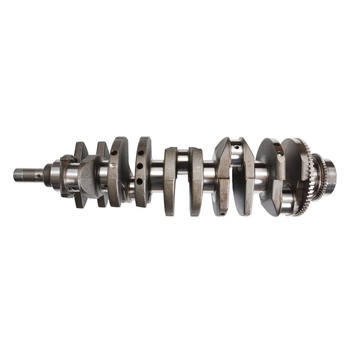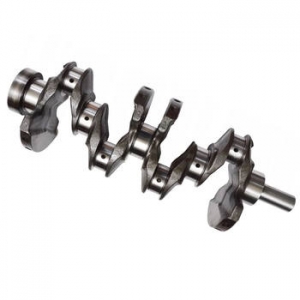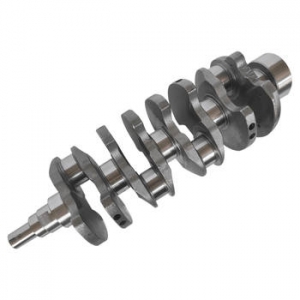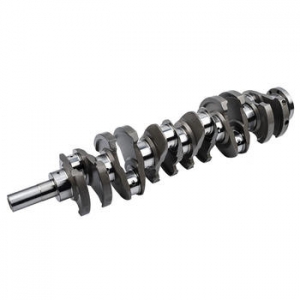In the heart of every internal combustion engine lies a critical component that translates linear piston motion into rotational output: the crankshaft. While seemingly simple in function, its design and material are paramount to an engine's performance, durability, and reliability. When discussing high-performance applications, heavy-duty industrial machinery, or even robust automotive engines, the term "forged steel crankshaft" frequently comes up. But what exactly sets a forged steel crankshaft apart from its counterparts, and why is this manufacturing method so highly regarded? The answer lies deep within the material science and the inherent mechanical advantages bestowed by the forging process itself. It's not just about raw strength; it's about how that strength is structured and distributed to withstand immense forces and stresses that would cause lesser components to fail spectacularly. Understanding this distinction is key to appreciating the engineering marvel that powers everything from race cars to essential infrastructure equipment.
The Fundamental Advantage: Why Forging?
To truly grasp the significance of a forged steel crankshaft, we must first understand the fundamental difference between forging and casting. Casting involves melting metal and pouring it into a mold, allowing it to solidify. While cost-effective for many applications, this process can leave internal voids, porosity, and an inconsistent grain structure, creating weak points. Forging, on the other hand, is a process of shaping metal using localized compressive forces, often when the metal is hot but still solid. Think of it like sculpting hot clay, but with massive hammers or presses. This mechanical working forces the metal's grain structure to align with the shape of the part, following the contours and load paths. This creates a dense, uniform, and directional grain structure that is far superior in terms of strength, fatigue resistance, and impact tolerance compared to cast metals. Frankly speaking, this difference in grain structure is where the forged steel crankshaft earns its reputation for exceptional durability under extreme conditions.
Forging vs. Casting: A Structural Deep Dive
Delving a little deeper into the structural differences between forged and cast crankshafts reveals the core reasons for choosing one over the other, particularly in demanding scenarios. Cast crankshafts, while adequate for many standard passenger car engines operating under moderate loads, possess a relatively isotropic (uniform in all directions) grain structure, but often with inherent microscopic imperfections from the cooling process. These imperfections can act as stress risers, initiation points for cracks that propagate under cyclic loading. Forged crankshafts, conversely, benefit from the anisotropic (directionally aligned) grain flow resulting from the mechanical deformation during forging. This aligned grain structure is significantly more resistant to fatigue cracking and can absorb higher impact loads without fracturing. To be honest, this grain alignment is the unsung hero behind the longevity and robustness of a forged steel crankshaft in high-stress environments. It's a direct result of how the metal is physically worked and shaped.
The Forging Process Explained: Crafting Strength
Creating a forged steel crankshaft is a multi-step process requiring precision, powerful machinery, and metallurgical expertise. It typically begins with a high-quality steel billet or bar, often a specialized alloy selected for its strength and hardenability. This billet is heated to a specific temperature within its forging range, where it becomes malleable but not molten. The heated billet is then placed into a die and subjected to immense pressure or repeated hammer blows. This can involve open-die forging for initial shaping or, more commonly for crankshafts, closed-die forging, where the metal is forced to fill a cavity shaped like the final part. Subsequent steps involve trimming flash (excess metal squeezed out), cooling, and often multiple heat treatment cycles to achieve the desired hardness, toughness, and residual stress profile. Interestingly enough, the cooling rate and precise temperature control during heat treatment are just as crucial as the forging pressure itself in developing the final mechanical properties of the forged steel crankshaft.
Key Stages in Crankshaft Forging
Breaking down the forging process into its key stages helps illustrate the complexity and control required. First is billet preparation and heating, ensuring uniform temperature throughout the material. Next comes the actual forging – using presses or hammers to deform the hot steel into the rough shape of the crankshaft. This is often followed by a blocking operation to refine the shape before the final impression die forging. Once the part is formed, flash removal is necessary. The crucial steps of heat treatment then follow, typically involving normalizing, quenching, and tempering to achieve the optimal balance of hardness and toughness. Finally, the forged blank undergoes extensive machining to create the precise journals, counterweights, and flanges required for engine assembly. Each stage is critical; imperfections introduced at any point can compromise the integrity of the final forged steel crankshaft, highlighting why quality control is paramount throughout the entire manufacturing chain.
Material Science Behind the Strength
While "steel" is the base, the specific alloy composition is vital for a forged steel crankshaft designed for demanding applications. High-strength alloy steels, often containing elements like chromium, molybdenum, nickel, and vanadium, are commonly used. These alloying elements enhance the steel's hardenability, strength, wear resistance, and fatigue life. The carbon content is also carefully controlled to achieve the desired hardness after heat treatment. For example, steels like 4340, 5140, or EN40B (when nitrided) are popular choices in performance and heavy-duty crankshafts due to their excellent balance of strength and toughness after being properly forged and heat-treated. The microstructure of the finished component – the arrangement and characteristics of phases like ferrite, pearlite, bainite, or martensite – is a direct result of the alloy chemistry, the forging thermal history, and the subsequent heat treatment. This intricate relationship between composition, processing, and microstructure is what ultimately dictates the performance ceiling of a forged steel crankshaft.
Understanding Steel Alloys for Crankshafts
Choosing the right steel alloy for a forged steel crankshaft is a decision based on the intended application's stress levels, operating temperatures, and required lifespan. For instance, an engine designed for sustained high RPM and extreme boost pressures will demand a different alloy than one intended for constant high torque in a heavy truck. Alloys with higher nickel and chromium content typically offer greater toughness and hardenability, making them suitable for highly stressed racing applications. Molybdenum improves strength at elevated temperatures and enhances hardenability. Vanadium can contribute to finer grain size and improved fatigue strength. Many experts agree that achieving the optimal performance from a forged steel crankshaft starts with specifying the correct alloy steel, followed by meticulous control over the forging and heat treatment processes. It's a complex interplay of material properties and manufacturing precision.
Performance and Durability Benefits
The choice of a forged steel crankshaft delivers tangible benefits directly impacting engine performance and longevity. Due to its superior strength and fatigue resistance, a forged crankshaft can withstand significantly higher loads than a cast one. This allows for increased power output through higher engine speeds, greater cylinder pressures (e.g., from turbocharging or supercharging), and higher torque. In applications like racing, where components are pushed to their absolute limits, the reliability offered by a forged steel crankshaft is non-negotiable. Furthermore, its inherent toughness makes it more resistant to fracture under shock loads or unexpected events. While the initial cost might be higher, the extended lifespan and ability to handle demanding conditions often make the forged option more cost-effective in the long run, especially for high-performance engine crankshafts or industrial power units where downtime is expensive.
Where Forged Crankshafts Shine
Have you ever wondered why top-tier racing engines, heavy-duty trucks, high-performance sports cars, and critical industrial power generators almost exclusively use forged crankshafts? It boils down to reliability under stress. In these applications, engines experience tremendous forces – inertial loads from high RPM, bending moments from piston forces, and torsional vibrations. A cast crankshaft, even if beefed up, simply cannot offer the same margin of safety or fatigue life as a properly manufactured forged steel crankshaft. They are indispensable in situations where failure is not an option, whether it's completing a race, hauling a maximum load, or ensuring uninterrupted power supply. The ability to handle extreme duty cycles and unpredictable shock loads is a hallmark of components produced via heavy-duty crankshaft forging processes, setting them apart from less robust alternatives.
Applications and Markets
The applications for forged steel crankshafts are diverse and span multiple industries where engine reliability and power density are critical. Automotive high-performance and racing markets are obvious users, seeking maximum power and endurance. Heavy-duty trucks and off-highway equipment rely on them for durability under constant heavy loads and harsh conditions. Marine engines, both for leisure and commercial vessels, benefit from their resistance to cyclic stresses and corrosion (when properly protected). Industrial engines, used in power generation, pumps, and compressors, require the long-term reliability that only forging can consistently provide. Even in some aerospace and defense applications, where reliability is paramount, forged crankshafts play a vital role. This widespread adoption across demanding sectors is perhaps the strongest testament to the inherent value and performance of the forged steel crankshaft.
Custom Solutions for Unique Needs
While standard forged crankshafts are available, many high-performance and specialized applications require custom crankshaft manufacturing. This involves designing a crankshaft tailored to specific engine requirements, such as unique stroke lengths, journal diameters, counterweight configurations, or material specifications. Custom forging allows engineers to optimize weight, balance, and strength for peak performance in a particular engine build. This could involve designing a crankshaft for a significantly destroked or overstroked engine, integrating specific features for dry-sump lubrication, or optimizing counterweighting for unique firing orders. Forged steel is the material of choice for these custom projects because the process can accommodate intricate designs while retaining maximum structural integrity. It allows for the creation of truly bespoke engine components built to withstand pressures far exceeding standard designs.
Ensuring Quality: Inspection and Testing
Given the critical role of the crankshaft, rigorous quality control is essential throughout the manufacturing process. This includes inspecting the raw material billet for internal defects, monitoring heating temperatures, verifying die dimensions, and visually inspecting the hot forging. After forging and heat treatment, non-destructive testing (NDT) methods are commonly employed. Magnetic particle inspection is used to detect surface and near-surface cracks. Ultrasonic testing can identify internal flaws or voids missed in earlier stages. Dimensional inspection using coordinate measuring machines (CMM) ensures that journal diameters, strokes, and flange mounting surfaces are within tight tolerances. Hardness testing verifies that the heat treatment has achieved the desired material properties. Balancing the finished crankshaft is also a crucial step to minimize vibration in the running engine. This multi-layered inspection process ensures that every forged steel crankshaft meets stringent performance and safety standards.
The Importance of Professional Inspection
For those involved in engine building or heavy machinery maintenance, understanding the signs of a healthy versus a compromised crankshaft is key. Visual inspection for cracks, especially in radii and journal surfaces, is a first step, but it's limited. Professional inspection using NDT methods is highly recommended for used crankshafts or when assessing a component from a high-stress application. Detecting a tiny sub-surface crack before it propagates can prevent catastrophic engine failure. Furthermore, verifying journal wear and straightness is critical for engine rebuilds. Relying on expert assessment and proper testing procedures for forged steel crankshafts is an investment in reliability and performance. It's frankly speaking, the only way to be certain of the component's integrity before entrusting it with the immense forces generated within an engine.
Choosing the Right Crankshaft Solution
Deciding whether a forged steel crankshaft is necessary for your application depends on several factors, including the engine's intended power output, operating conditions, budget, and expected lifespan. For standard, low-to-moderate output engines used in typical passenger cars, a cast crankshaft is often sufficient and more economical. However, if you are building a performance engine, planning to add forced induction, working with heavy-duty industrial equipment, or require maximum reliability under constant stress, the added cost of a forged steel crankshaft is usually well justified. Its superior strength, fatigue resistance, and ability to withstand shock loads provide an essential margin of safety and significantly extend the engine's potential lifespan and performance envelope. Considering the potential damage and cost of failure in demanding applications, the durability offered by forging becomes an undeniable advantage.
Our Contribution to Crankshaft Excellence
With deep experience in metallurgical processes and precision manufacturing, our company specializes in providing high-quality forged steel crankshafts for a range of demanding applications. We utilize advanced forging techniques and stringent quality control measures, from raw material inspection to final dimensional checks and balancing. Our expertise allows us to produce crankshafts that meet the exacting standards required for performance engines, heavy-duty equipment, and industrial machinery. Whether you need a standard forging or a custom-designed solution, we leverage our capabilities in heavy-duty crankshaft forging and precision machining to deliver components that offer exceptional strength, durability, and reliability. We understand the critical role the crankshaft plays and are committed to providing solutions that engine builders and operators can trust under the most challenging conditions.
Conclusion: The Unmatched Value of Forging
In conclusion, the forged steel crankshaft stands as a testament to the power of metallurgy and mechanical engineering. Its inherent strength, born from the process of mechanically working the steel to align its grain structure, makes it the superior choice for any application where the crankshaft will face significant stress, cyclic loading, or potential shock. From race tracks to remote power generation sites, the reliability and performance ceiling offered by a forged crankshaft are simply unmatched by cast alternatives. While the initial investment may be higher, the long-term benefits in terms of durability, performance capability, and reduced risk of catastrophic failure make it a wise and often necessary choice for demanding engine builds and critical machinery. Understanding its advantages is key to building engines that perform reliably and last longer under challenging conditions. For those seeking the ultimate in crankshaft strength and longevity, forging is undoubtedly the path forward.
For more detailed information, please visit our official website: forged steel crankshaft





